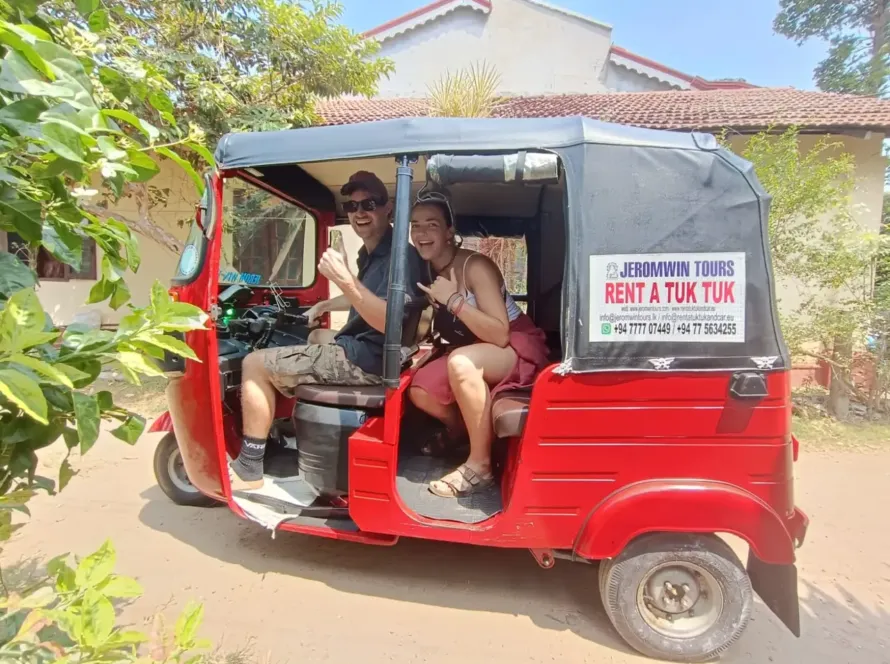Traveling in Sri Lanka is an adventure of its own, but navigating its streets on a tuktuk takes the experience to a whole new level. This guide is your ultimate companion to exploring the island with the charm and agility of a tuktuk, ensuring you’re equipped with all the know-how to make your journey smooth, safe, and utterly unforgettable.
What is a Tuktuk?
A tuktuk, essentially, is a motorized three-wheeled vehicle commonly found meandering through the streets of Sri Lanka. It’s compact, agile, and able to navigate through the tightest of spaces, making it an ideal choice for traversing the bustling city streets and serene countryside alike. Not just a mode of transport, tuktuks are a cultural icon, offering a unique and intimate way to experience the local way of life.
Originating from the simple need for efficient and accessible transportation, the tuktuk has evolved into a symbol of Sri Lankan ingenuity and hospitality. Its open sides allow for a sensory experience like no other, where you’re not just a spectator but a part of the vibrant life unfolding around you.
Why Travel by Tuktuk in Sri Lanka?
Traveling by tuktuk offers an unparalleled sense of freedom and adventure. Unlike the confines of a car or bus, a tuktuk immerses you directly in the sights, sounds, and scents of Sri Lanka. You can stop anywhere, anytime, to capture a moment, explore a hidden gem, or have a spontaneous chat with the locals.
Moreover, tuktuks are a sustainable and economically efficient mode of transportation. Their small size reduces road congestion and their fuel efficiency is favorable for both your wallet and the environment.
How to Rent a Tuktuk in Sri Lanka
Renting a tuktuk in Sri Lanka is a simple process, involving a valid driving license, some paperwork, and a sense of adventure. Start by choosing a reputable rental agency, many of which offer online booking options. You’ll need to present a valid driving license from your country along with an international driving permit.
Rental agencies often provide a brief training session to acquaint you with tuktuk driving. It’s crucial to understand the local traffic rules and the tuktuk’s operation to ensure your safety and enjoyment on the roads.
You should also inquire about insurance options to cover any possible damages or accidents during your travels. Once the paperwork is complete, you’re ready to embark on your tuktuk adventure across the island.
Navigating the Roads: Tips and Tricks
Navigating Sri Lankan roads on a tuktuk can be daunting at first, but with a few tips and tricks, you’ll be cruising like a local in no time. First and foremost, always keep a map or GPS device handy, as Sri Lankan roads can be complex and sometimes poorly marked.
Anticipate the unpredictability of local traffic, which often includes pedestrians, animals, and other vehicles in unexpected places. Patience and a calm demeanor go a long way in navigating these challenges successfully.
Understanding Sri Lankan Road Culture
Sri Lankan road culture is a fascinating blend of etiquette and chaos. Horns are used frequently, not in aggression, but as a courteous way to signal one’s presence. It’s a language of its own, one that you’ll quickly learn to speak and interpret.
Respect for local customs is paramount. For instance, allowing monks or schoolchildren the right of way reflects well on your understanding and respect for local culture.
Top Routes and Destinations for Tuktuk Travelers
Sri Lanka is home to some breathtaking routes that are perfect for tuktuk exploration. The coastal road from Galle to Matara offers stunning ocean vistas, while the hill country roads through tea plantations present a cool and misty experience.
For a blend of cultural and natural experiences, the journey from Kandy to Ella is unbeatable, with stops at historical sites and views of rolling hills. Each route offers its own charm, revealing the rich diversity of Sri Lanka’s landscape.
Safety Measures and Local Laws
Safety should always be a top priority when traveling by tuktuk. Always wear your helmet, even for short distances, and make sure to have the necessary safety equipment, including a first-aid kit and a spare tire.
Familiarize yourself with local traffic laws. For example, Sri Lanka drives on the left-hand side of the road, and seat belts are a must. Adhering to these rules will ensure a safe and trouble-free journey.
Interacting with Locals: Do’s and Don’ts
Interacting with locals can be one of the most rewarding aspects of your tuktuk journey. Always greet people with a smile and a polite ‘Ayubowan’ (a traditional greeting meaning ‘long life’). However, understand and respect local customs and privacy. Ask permission before taking photos, and always be respectful of people’s homes and businesses.
Learning a few phrases in Sinhalese can go a long way in building rapport with the locals. Simple phrases like ‘Karunakara’ (please) and ‘Isthuthi’ (thank you) can make your interactions smoother and more meaningful.
What to Pack for Your Tuktuk Journey
Packing wisely can significantly enhance your tuktuk travel experience. Essentials include lightweight and breathable clothing, a reliable sunscreen, and mosquito repellent. Given the unpredictable weather, a raincoat or a small umbrella is also advisable.
Don’t forget to pack a basic toolkit for the tuktuk, including items for minor repairs. A portable charger and a good water bottle are also must-haves on your checklist, ensuring you stay connected and hydrated during your adventure.
Embarking on Your Tuktuk Adventure
Now that you’re armed with the essentials of tuktuk travel in Sri Lanka, from discovering the best routes to understanding local etiquette, you’re all set for an exhilarating journey. Remember, the key to a successful tuktuk adventure lies in preparation, respect for local customs, and an open heart ready to embrace every bit of the beauty and diversity Sri Lanka has to offer. So, start your engines, and let the adventure begin!



